FMBG 16 – Oncogenes and Cancer Genetics – Flashcards
Unlock all answers in this set
Unlock answersquestion
He made a point of saying that cancer rates have been rising in recent years. - Food and overconsumption has become an increasingly more studied route of potential cancer growth due to potential oxidative stress and cellular inflammation. It has to do with adipose cells and cytokine levels rising that lead to increase in cancer risks. - Lung related cancers are the leading cause of caner mortalities in both males/females. - Also worth noting that prostate cancer in men and breast cancer in women serve as the most prevalent forms of new cancer diagnoses in recent years. - Decrease in stomach cancer is probably due to greater reliance on refrigeration and less fermented foods

answer
General info on cancer
question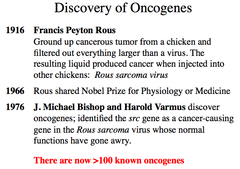
In the course of history, the cause for cancer was pinpointed down to a virus, then down to a gene in that virus. For exact names and years, the cupcake bet applies. - The important thing about these discoveries is the notion that normal cellular genes can be modified to cause cancer

answer
Brief history of oncogenes
question
More important than the technical details was the revolution the discovery of oncogenes caused in the thinking about cancers: - "If a cellular gene can cause cancer, then aberrations of normal cellular metabolism can cause cancer" - We thought of cancer largely as something from outside (mostly communism). Research into cancer became much more dynamic - Highlighted normal cellular function and how mutations can mess that up.
answer
Discovery of oncogenes and the way of thinking
question
An oncogene is a mutated or overexpressed cellular gene that causes cancer
answer
Oncogenes
question
A proto-oncogene is a normal cellular gene that can become an oncogene via mutation.
answer
Proto-oncogenes
question
Gain-of-Function Mutations - Proto-oncogenes ? oncogenes Loss-of-Function Mutations - tumor supressor genes
answer
Conversion of a Proto-oncogene into an Oncogene
question
proto-oncogene ? oncogene. - This can mean over-expression or an inability to turn it off. - These mutations are DOMINANT (you only need it on one allele for cancer).

answer
Gain of function (GOF) mutation
question
- Example 1: Remember that losing the off button is overall gain of function. I say this because for raf, gain of function mutation would be loss of GTPase activity, but that loss causes an inability to turn off (prevents monomeric G protein from inactivating), leading to cancer. - Example 2: Gain of function mutation for a growth factor receptor would lead to constitutive activity (responding in the absence of a bound ligand).
answer
GOF mutation examples
question
- causes tumor suppressor genes to become inactive. - These are generally RECESSIVE, meaning you would need it on both alleles (or have it on one allele then lose the second chromosome) for it to have effect. - Underactivity mutation tends to be recessive because there may be less activity with one silenced allele but the other can still produce. - Example 1: STAT protein: losing tyrosine would ultimately mean it can't be activated.

answer
Loss of function (LOF) mutation
question
"what kind of a mutation in a ras would be a gain of fuction mutation?" Loss of GTPase activity. Prevent monomeric protein from inactivating itself. - "what kind of a mutation in a growth factor receptor would be a gain of function mutation" constitutive activity. Due to a deletion or point mutation, that cytoplasmic domain of receptor is always active. Whatever kind of protein that has an activity, you can imagine a mutation that would render it permanently active. Loss of function: retinoblastoma genes. When you lose that function, you're allowing something else to become constitutively active.
answer
Examples of gain of function (GOF) vs Loss of function (LOF)
question
- Deletion or point mutations in coding sequences - Regulatory mutations - Gene amplification - Chromosome rearrangement

answer
variety of mutations that can cause a proto-oncogene to convert into an oncogene
question
Our interest has been in deletion or point mutations. - Don't be surprised if he gives us an example of proteins and ask which of these is a GOF. - If he were to say "what kind of mutation in a step protein would be a LOF mutation?" you would say: lose a tyrosine where it is never phosphorylated and can't be activity. - "Theoretical gain of function?" It developed legs and it can run. Any mutation that allows it to dimerize without phosphorylation. Go back and listen to the lecture capture.

answer
variety of mutations that can cause a proto-oncogene to convert into an oncogene (my notes
question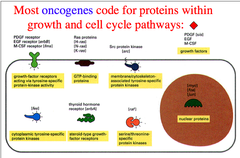
1. Growth factors 2. Growth factor receptors 3. Intracellular signal transducers 4. Nuclear transcription factors Note that all of these proteins are in the growth and cell cycle pathways. - Focus on the class of proteins (attached). I wouldn't memorize the specific examples - just familiarize yourself with the names so you won't freak out if he uses any as an example on the test. - NOTE: Most cancers have mutations in ras.

answer
Most oncogenes code for proteins within growth and cell cycle pathways
question
Most cancers have mutations in ras.

answer
Most cancers have mutations in ____________
question
- The slide shows how they found the oncogene v-ras from human bladder cancer. - Basically you take the DNA from the human bladder cancer cell, chop it up, transfect into mouse DNA, plate them and see if you get any tumor cells/loci (one in a million), pick those off and find the human DNA in it using a library, and voila you have the oncogene! - The idea is that you've found the part of the cancer cell's DNA that made it develop tumors by seeing which part of the DNA made mouse cells develop tumors. - v-ras is also found in the Harvey murine sarcoma virus. 20% of all human cancers involve c-ras mutations, so ras is a common player in cancer.

answer
v-ras experiment
question
The ERK MAPK cascade is persistently activated by oncogenes in cancer. Dr. Sherman didn't spend too much time here, but note that EGFR overexpression, EGFR mutation, Ras mutation and B-Raf mutation trigger the ERK MAPK cascade and are responsible for significant portions of many different cancers. - The take home points here are that mutations in this cascade or pathway have effects on nuclear transcription and this can lead to cancer. Rad and Raf are two importan proteins that can be mutated to cause a variety of cancers. It can also lead to EGFR overexpression via Erk mediated transcription. This creates an autocrine feedback loop that is critical in the genetic alterations seen in Ras/Raf. Take home: mutations in this pathway are interrelated
answer
Oncogene activation of the ERK MAPK cascade
question
1. germ line 2. somatic

answer
Categories of Gene Mutations that Give Rise to Cancer
question
mutations occurring in the egg or sperm and are therefore heritable and can cause cancer family syndromes (i.e. BRCA1)
answer
Germ line cancer mutations
question
non inheritable mutation in non germ line cells that are more worried about because often brought on by environmental factors and lifestyle
answer
Somatic cancer mutations
question
- *Driver mutations:* are causally implicated in oncogenesis. They confer a growth advantage on the cancer cell (i.e. ras/raf). Less common. - *Passenger mutations:* have not conferred clonal growth advantage and have not contributed to cancer development, but are within cancer genomes as inert somatic mutations and are present in the final cancer. More common - ? Present in tumors and are simple passengers and reflect the mutation rate of the environment or we just don't understand yet their contribution to mutation.
answer
Driver vs. passenger mutations
question
Mutations may be acquired while the cell lineage is phenotypically normal, reflecting both the intrinsic mutations acquired during normal cell division and the effects of exogenous mutagens. During the development of the cancer other processes, for example DNA repair defects, may contribute to the mutational burden. Passenger mutations do not have any effect on the cancer cell, but driver mutations will cause a clonal expansion. Relapse after chemotherapy can be associated with resistance mutations that often predate the initiation of treatment.

answer
Slide on how cells accumulate driver and passenger mutations in a person's lifetime.
question
Number of things that happen to a cell that confer a growth advantage, some of which we don't understand. One of his favorites is the growth advantage that occurs via warburg effect. It effectively states that cancer states prefer to undergo anaerobic metabolism of glucose. They tend to metabolise glucose to lactate instead of oxidative metabolism. The warburg paradox: given the fact that cancer have growth advantage, why do they scimp on ATP: 2 AT vs 30 ATPs? Maybe it shouldn't be called a paradox because the difference between aerobic vs anaerobic metabolism are the products of glucose. Products of aerobic metabolism: CO2, for anaerobic is lactate. 3 carbons vs 1 carbon, and 3 carbon molecules can build things while 1 carbon cannot. Cancers need precursors for macromolecule biosynthesis. The warburg effects seems to empower cancer cells by making precursors for growth. Secondary effect of starving neighboring cells of glucose

answer
Warburg effect (my notes)
question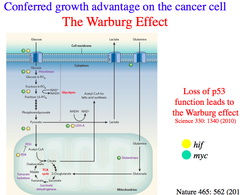
- The Warburg effect is a conferred growth advantage in the cancer cell where it prefers anaerobic metabolism (glucose?lactate) even in the presence of oxygen - Just remember the possible advantages of cancer cells using anaerobic metabolism: 1. it produces 3-carbon lactate, which can be used to build other things (unlike the 1-carbon CO2 you'd get from aerobic) 2. it's not as efficient of a use of glucose, so they end up outcompeting neighboring cells for glucose

answer
Warburg effect
question
Contrary to what was expected, cancer cells were found to undergo anaerobic respiration, thereby altering their surrounding environment and other cells in that environment as well as outcompeting neighboring cells for glucose. Cancer cells utilize less glucose in this pathway but Dr. Sherman made two interesting points. First, the ATP deficit may make sense because through oxidative phosphorylation cells produce CO2, which is not a good carbon skeleton for other anabolic processes. Additionally, the anaerobic pathway does not require the presence or use of mitochondria like aerobic respiration would. Since mitochondria play a crucial role in apoptosis, it is thought that this is implicated in cancer cell's ability to avoid cell death. These are all just hypotheses remember.
answer
Warburg effect 2
question

answer
Autosomal dominant
question

answer
Autosomal recessive
question
is the age-adjusted fraction of those with the gene that express the trait by showing signs or symptoms of disease, in this case hereditary cancer. - So even if you inherit an oncogene that is autosomal dominant, it doesn't always mean you'll 100% get cancer by a certain age. - Instead, depending on the oncogene you'd have different penetrance, like 20% for BRCA1, for example. - Anything less than 100% gives you a genetically legitimate chance at not getting cancer, which is what incomplete penetrance is. (This has to be all-or-none as you can't kinda have cancer.)

answer
Penetrance
question
When the frequency of expression of the phenotype, for individuals who have the mutant gene, is less than 100% the gene is said to show incomplete penetrance. It is an all or none concept.
answer
incomplete penetrance
question
- autosomal dominant cancers can show reduced penetrance, less than the usual 100% you'd expect from Mendelian autosomal dominant phenotypes. - However, autosomal recessive cancers show COMPLETE penetrance (100%). - In the example in slide 25, remember that blue is has cancer (complete penetrance) and white is does not have cancer (incomplete penetrance). You can clearly have the allele (passed it on to children) and not have cancer.

answer
Said another way
question
- Modifier genes - Carcinogens - Response to DNA damage - Hormonal/reproductive factors - This is really where most lifestyle choices or examples of decreasing risks to exposure of cancer is important. Influences penetrance of genes you already possess. UV light. As we age, as we accumulate these exposures, this can influence the dominant gene's expression i.e. penetrance. - This is why cancer is such an age dependent disease.

answer
Factors affecting penetrance
question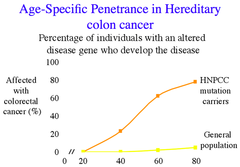
As they begin reaching significant years. The number of men who died with signs of prostate cancer in autopsies is huge, but doesn't mean they were phenotypic.

answer
Age-Specific Penetrance in Hereditary colon cancer
question
Basically, possibility of cancer accumulates and that is directly related to age

answer
Cancer incidence as a function of age
question
Expressivity is the SEVERITY of expression of the phenotype (cancer) among those with the same disease causing genotype (oncogene). - You can have differing expressivity even in people with the same genotype, in which case that gene has variable expressivity

answer
Expressivity
question
Penetrance is 'you have the mutant gene, will you get cancer?' - expressivity is 'you've got cancer, now how bad is it?'.
answer
Expressivity vs penetrance
question
An example of expressivity (very severe vs mild) - Low expressivity, but both have 100% penetrance.

answer
neurofibromatosis type I
question
Most genes that cause cancer susceptibility are dominant and have incomplete penetrance. - To the outside observer it can seem random. The last line is the key takeaway: individuals inherit altered cancer susceptibility genes, not cancer.

answer
In general, most genes that cause cancer are ____________
question
This hypothesis aimed to explain the early onset at multiple sites in the body of an inherited form of cancer called hereditary retinoblastoma. - Inheriting one germline copy of a damaged gene present in every cell in the body was not sufficient to enable this cancer to develop. - A second hit (or loss) to the good copy in the gene pair could occur somatically, though, producing cancer. - This hypothesis predicted that the chances for a germline mutation carrier to get a second somatic mutation at any of multiple sites in his/her body cells was much greater than the chances for a non carrier to get two hits in the same cell. - Basically, this hypothesis postulates that an initial germline mutation with incomplete penetrance will require another significant driver mutation or many in order to amplify overall penetrance of the original mutation.

answer
Two hit hypothesis
question
Reverse transcriptase: an enzyme that makes complementary DNA from an RNA template via reverse transcription.
answer
Reverse transcriptase
question
On the basis of age-incidence statistics, it has been suggested that common adult epithelial cancers such as breast, colorectal and prostate require 5-7 rate-limiting events (driver mutations?) ... perhaps more. - 350 (1.6%) of the ~22,000 protein-coding genes in the human genome show recurrent somatic mutations in cancer with strong evidence that these contribute to cancer development. 90% are dominant
answer
Something
question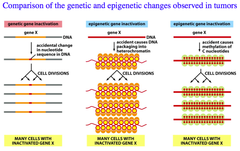
tumors can arise from genetic changes AND epigenetic changes such as silencing and gene inactivation.

answer
Comparison of the genetic and epigenetic changes observed in tumors
question
do it
answer
Check last slide audio



